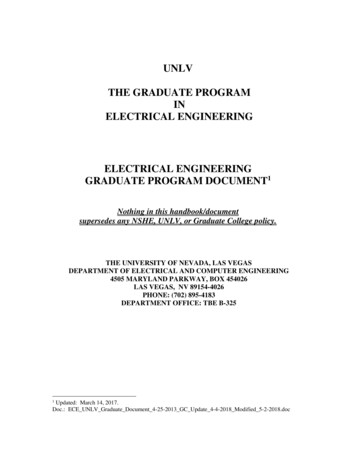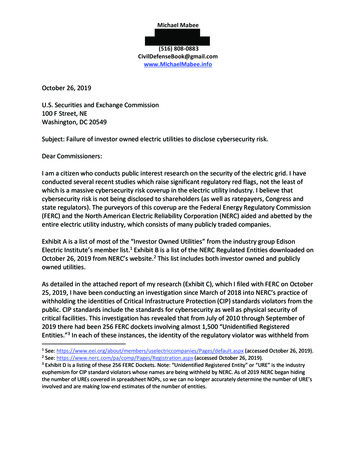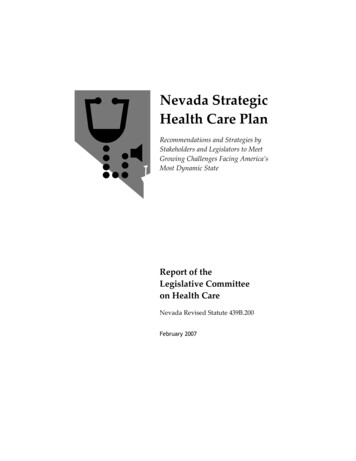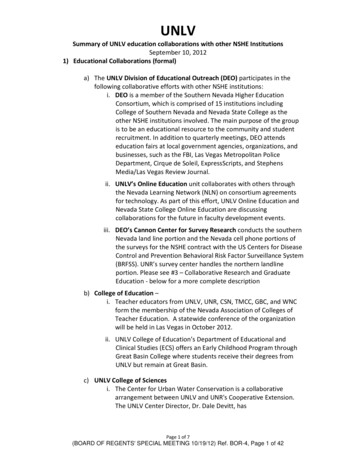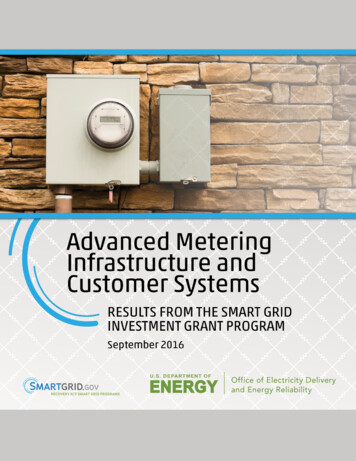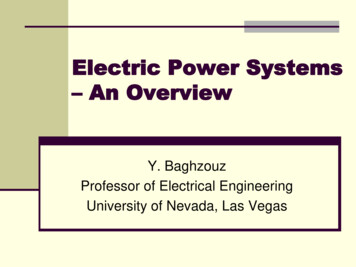
Transcription
Electric Power Systems– An OverviewY. BaghzouzProfessor of Electrical EngineeringUniversity of Nevada, Las Vegas
Overview Power Generation Conventional power generation Power generation from renewables Power transmission Cables and other transmission system equipment Power Distribution Distribution system equipment Power Utilization Demand curves Power System Analysis Power flow, fault currents, economic dispatch.
Basic Conventional Power System LayoutConventional (non-renewable)primary energy source
US Electricity Generation by FuelFor latest trend, see /365650871.html
Coal Fired Power Plants:Number of Generators 1,450Total Capacity 350 GW(Source: http://www.npr.org)
Diagram of a modern coal power plant(Source: Masters, Renewable and Efficient Electric Power Systems, 2004)
Steam Turbines and their Governors Steam turbines can have non-reheat, single-reheat or double-reheat. The steam flow is controlled by the governor. The main amplifier ofthe governing system and valve mover is an oil servomotor that iscontrolled by a pilot valve. Main and reheat stop valves are normally fully open - they areused only during generator start-up and shut down.
The electric generatorGovernor controls turbine torque and powerExciter controls voltage and reactive power
Nuclear Power Plants:Number of Generators 100Total Capacity 100 GW
Diagram of a nuclear power plant Types of nuclear reactors: Pressurized Water Reactor (PWR) Boiling Water Reactor (BWR)Nuclear Fission
Natural Gas Power Plants:Number of Generators 5,500Total Capacity 450 GW
Open cycle gas turbine:Typical efficiency: 30-35%Air-breathing jet engines are gasturbines optimized to produce thrustfrom the exhaust gases. In ourcase, the system is optimized toproduce maximum shaft power.
Combined cycle power plant:Typical efficiency: 60-65%Efficiencies are even higher when the steam is used for district heatingor industrial processes.
Hydro Power Plants:Number of Generators 4,000Total Capacity 80 GW
Hydro Power plants Low and medium head plantsuse Francis turbines High head plants use Peltonwheel turbines
Electricity production from renewablesHYDRO
Hydropower is renewable Hydropower relies on the watercycle. Herein: Solar energy heats water onthe surface, causing it toevaporate. This water vapor condensesinto clouds and falls back ontothe surface as precipitation(rain, snow, etc.). The water flows through riversback into the oceans, where itcan evaporate and begin thecycle over again
Renewable Power Plants: Large plants areconnected to the sub-transmission or transmission system
Renewable Power Plants: Small plants areconnected to the distribution system (often on the load side)
Electricity production from renewables:Photovoltaics
Growth in Solar Photovoltaic
PV Plants in Nevada:
Electricity production from renewables:concentrating Solar power
Concentrating Solar Power (CSP) CSP technologies use mirrors to reflect andconcentrate sunlight onto receivers that collect the solarenergy and convert it into heat. This thermal energy can then be used to produceelectricity via a steam turbine or heat engine driving agenerator. CSP systems are typically classified by how the varioussystems collect solar energy. The three main systemsare The linear systemThe tower systemThe dish system.
Concentrating Solar Power CSP technologies use mirrors to reflectand concentrate sunlight onto receiversthat collect the solar energy and convertit into heat. This thermal energy can then be used toproduce electricity via a steam turbine orheat engine driving a generator.Nevada Solar 1 (65 MW)
Power tower CSP
Electricity production from renewables:Biomass
Biomass EnergyLandfill Energy near Las Vegas, NV (12 MW)
Electricity production from renewables:Ocean power
Capturing Ocean PowerAttenuatorTidal PowerOscillating Water ColumnPoint AbsorberOcean Current
Electricity production from renewables:Wind
Wind Power
Installed Wind Capacity by Country (MW)Denmark has broken another record of wind energy in 2015, having generated an astonishing42% of its power from windmills, the highest share ever produced by any country.Source: http://www.energymarketprice.com/
Wind Power in Nevada:Spring Valley Wind (Pine County): 152 MW
Electricity production from renewables:geothermalGEOTHERMAL
Geothermal Dry steam plants use steampiped directly from ageothermal reservoir to turn thegenerator turbines. The firstgeothermal power plant wasbuilt in 1904 in Tuscany, Italy. Flash steam plants take high-pressure hot water from deepinside the Earth and convert itto steam to drive the generatorturbines. When the steamcools, it condenses to waterand is injected back into theground to be used over andover again.
Geothermal in Nevada:Current Capacity: 385 MW( 150 MW in construction or development stage).Source: NV Energy Website
Basic Conventional Power System Layout
Step-up (Station) transformers: Size to 1000 MVAgenerator voltage up to 25 kVTransmission voltage up to 765 kVForced Air and Forced Oil Cooling.
Basic Conventional Power System Layout
US Power Transmission Grid
High Voltage Power Lines (overhead) Common voltages in north America: 138, 230, 345, 500, 765 kV Bundled conductors are used in extra-high voltage lines Stranded instead of solid conductors are used.
High Voltage Power Cables (underground) Cable lines are designed to be placed underground inurban areas or under water. The conductors are insulatedfrom one another and surrounded by protective sheath. Cable lines are more expensive and harder to maintain.They also have a large capacitance – not suitable for longdistance.
Tree Trimming underneath power linesBeforeAfter
Transmission System Protection Protective equipment needs toprotect the system from overvoltages (surge arrestors) andover-currents (circuit breakers).
Long line series and shunt compensation Shunt reactors are used to compensate the line shuntcapacitance under light load or no load. Series capacitors are often used to compensate theline inductive reactance in order to transfer more power.
Basic Conventional Power System Layout
Substation Transformers Typical size; 20 MVA Primary voltage down to 69 kV Secondary voltage down to 4.16kV
Distribution Substation Layout
Power distribution lines(placed underground in new urban areas) Primary Distribution voltages: 4.16, 12.47, 13.2, 13.8, 25, 34.5 kV
Power distribution transformers The distribution circuits may be overhead or underground.This will depend on the load density and the physicalconditions of the particular area to be served.
Switched Capacitors
Basic Conventional Power System Layout
Electrical Power Utilization (electric load) Utilization voltage: 120V, 208V*,240V, 277V, 480V*, 600V*2/3 –3/4 of electricity is consumed by motors
Demand Changes in demand of individual customers is fast andfrequent due to load switching.
Substation Load: 48 hours The aggregated demand at the substation is smoother,and total load fluctuations are usually small.
MW and MVAR loading on a feeder – 4 months
System load: 24-hours The aggregated demand on the system is even smoother, and total loadfluctuations are very small. The overall daily profile of load can be predicted reasonably well usingforecasting 1718192021222324System Load (MW)5000Hour of Day
Seasonal Load PatternsThe local load is dominated by winter and summer patterns, with Mayand October as shoulder months.
North American Electrical InterconnectionsThe power system of North America is divided into four major Interconnectionswhich can be thought of as independent islands. Western – Generally everything west of the Rockies.Texas - Also known as Electric Reliability Council of Texas (ERCOT).Eastern – Generally everything east of the Rockies except Texas and Quebec.Quebec.
System monitoring. Analysis, Operation and ControlImportant Studies: Economic generation scheduling and unit commitment Power flow analysis Short-circuit analysis System stability and dynamic analysis Load forecasting System planning Etc
Generation-load balance As electricity itself cannot presently be stored on a large scale,changes in customer demand are met by controlling conventionalgeneration, using stored fuels. Frequency is maintained as long as there is a balance betweenresources and customer demand (plus losses). An imbalance causesa frequency deviation.
Generator Scheduling (economic Dispatch) Given a power system with n generators, and a load forecast, determine theoptimal schedule of each generator while recognizing generating unit limitsand output capability.6000400030002000Base stem Load (MW)5000Hour of DayUnit # xUnit # yUnit # z
Power Flow AnalysisRed indicates undervoltage at Bus 3
END!
Steam Turbines and their Governors Steam turbines can have non-reheat, single-reheat or double- reheat. The steam flow is controlled by the governor. The main amplifier of the governing system and valve mover

